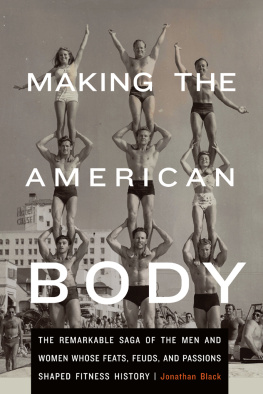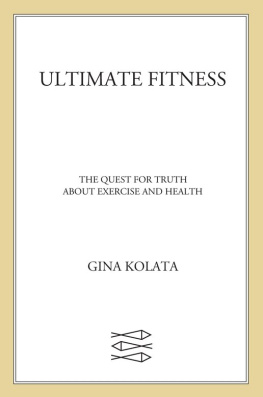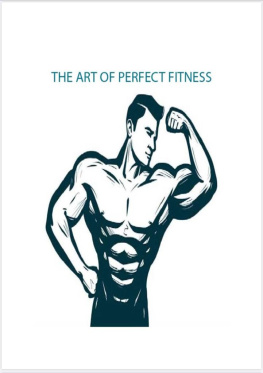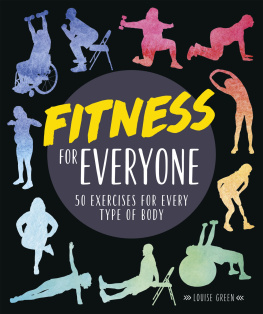

2013 by Jonathan Black
All rights reserved
Library of Congress
Cataloging-in-Publication Data
Black, Jonathan, 1943
Making the American body: the remarkable saga of the men and women whose feats, feuds, and passions shaped fitness history / Jonathan Black.
pages cm
Includes bibliographical references and index.
ISBN 978-1-4962-0950-4 ((electronic: e-pub)
ISBN 978-1-4962-0951-1 (electronic: e-mobi)
1. Physical fitnessUnited StatesHistory. 2. Health attitudesUnited StatesHistory. I. Title.
GV 510. U 5 B 53 2013
613.7dc23 2013008307
Set in Minion by Laura Wellington.
The publisher does not have any control over and does not assume any responsibility for author or third-party websites or their content.
For Adrian and Lucian
Preface
Fitness today is an all-consuming habit. Untold millions troop to health clubs or run on paths and tracks or work out at home on equipment peddled on late-night infomercials. Yoga is experiencing an unprecedented boom. There are Pilates studios and boot camps and Zumba parties. There are fitness facilities in every hotel, in corporate centers and tennis clubs, in spas and on cruise ships. Exercise touches every aspect of our culture, from books and magazines to television shows and high-end clothing boutiques. How we arrived at this state of heightened awareness is a story whose contours mirror much that happened in twentieth-century America, but it is also, on another level, the tale of individuals. Virtually no other habit or business has been so propelled, and for so long, by such a remarkable cast of characters.
As diverse as they were, all shared a singular passion to improve on the human body. Some happened on their mission by chance. Many latched on to exercise to overcome an early life that was blighted by illness, deprivation, or low self-esteem. Not surprisingly, few believed in moderation and fewer still in humility. Proud of their new physicality, they were big on self-promotion. The early icons with bodybuilder roots were the most likely exhibitionists, but shifting notions of fitness did little to alter their profile; almost all were crusaders with outsized egos and a flair for showmanship, and their occasional clashes made for enduring feuds and high comedy.
Singly and together, they shaped the habit of exercise in America, but their influence extended beyond the treadmill and yoga mat. They impacted advertising and figured large in the early use of television. They helped spawn the videotape industry. At a time when the demographics of the country were shifting, from rural to urban, they offered hubs for immigrants and a source of identity and confidence. In the daily shuttle between home and office, they introduced a new third place, the health club, a source of friendship and social interaction. The promise they offered, of personal transformation, touched a common feature of the American dream that anyone, with will and determined effort, could be a success and live a happier, more fulfilling life.
It can be said that their feats and stories fit no single narrative, that the very notion of a history of fitness weaves a misleading theme. The early muscle heads had little in common with the millions of converts to jogging; the addicts of Spinning would never deign to sit in the adjacent yoga studio. But this segmentation overlooks the progression that defines how Americans look at their bodies and how they employ them to further a sense of accomplishment and well-being, because most everything chronicled here was built on something that came before. The very notion of fitness appeared late in the game, but its provenance dates back to muscular Christianity and the nutritional zealots of the nineteenth century; it developed in the showmanship of Mr. Olympia contests and the drive to do better in sports; it fed off a national slump in self-confidence and the need to look good in the aerobics studio; it was a natural outgrowth of the coupling of exercise and health.
The end result of this history, it is fair to argue, has failed to fulfill its promise. The country is in the midst of an obesity epidemic, diabetes is on the rise, and so is the incidence of heart attack and stroke. One might conclude that the heroes of this book are partly to blame for their salesmanship and commercialism, for their occasional grandiosity and excesses. To do so, however, would be to overlook how far they have brought us. Their flaws and limitations need not detract from the vision and vitality that inspired so many. What they accomplished should set a standard for our own ambitions and what still needs to be done.
Introduction | A Night to Remember
There was plenty of entertainment in New York City that warm night in October 1924. Up in Times Square, the Ziegfeld Follies were playing at the New Amsterdam, the marquee proclaiming, A National Institution! Glorifying the American Girl! Around the corner, Gloria Swanson was starring in the Broadway smash The Impossible Mrs. Bellew . Harold Lloyd was cracking them up in his latest five-reel comedy riot, Grandmas Boy . Marion Davis was in her sixth capacity week in When Knighthood Was in Flower .
But for fans of something different, for connoisseurs of male flesh and muscle, there was only one place to be that night Madison Square Garden. This was the second Garden, the one designed by Stanford White, a huge, sprawling Moorish palace with a thirty-two-story minaret overlooking Madison Square at Twenty-Sixth Street. Atop the minaret an eighteen-foot bronze statue of a nude Diana had originally spun with the wind; deemed too erotic and possibly a danger to passersby below, it had been replaced with a much lighter, gilded hollow copy. The Gardens rooftop restaurant was the citys largest, as famous for its food as for the night when Henry K. Thaw shot White dead at his table because the architect had been having an affair with Thaws wife, Evelyn Nesbit, much of it carried on in the apartment that White kept in the building, the site of the notorious red-velvet swing.
The Garden was the only place big enough to accommodate the likely crowds. Its main hall was enormous, the largest in the world, with seating capacity for eight thousand people and floor space for thousands more. In recent years, the Garden had played home to all manner of shows rodeos and circuses and speed-walking races. It rarely made back its money, however, and entrepreneur Tex Rickard took over the arena to introduce the new sport of boxing. The night before, record-breaking numbers of fans witnessed a tough kid from Chicago, Charlie White, flatten the Canadian lightweight champ with a jackhammer left one minute into the second round.
There would be no fisticuffs tonight, but there would be plenty of macho display. Seventy-five men from around the world were here to show off their rippling abs and tree-trunk thighs. It was billed as The Worlds Most Perfectly Developed Man contest, and tickets were hard to come by.
The crowds had been lining up for hours. Policemen patrolled the lines brandishing night sticks. Brokers were waving tickets, yelling for more. Inside, in the basement dressing rooms, dozens of men methodically stripped off their clothes to begin their preshow ritual. Off came a shirt, the body turned sideways to the mirror, an arm cocked, the tight-roped bicep regarded with squinted satisfaction. Bodies hunched forward; shoulders leaped to life. A massive chest, a pulverizing clot of muscle, sprang into profile. Only the occasional grunt of confidence broke the tense silence.
Next page











